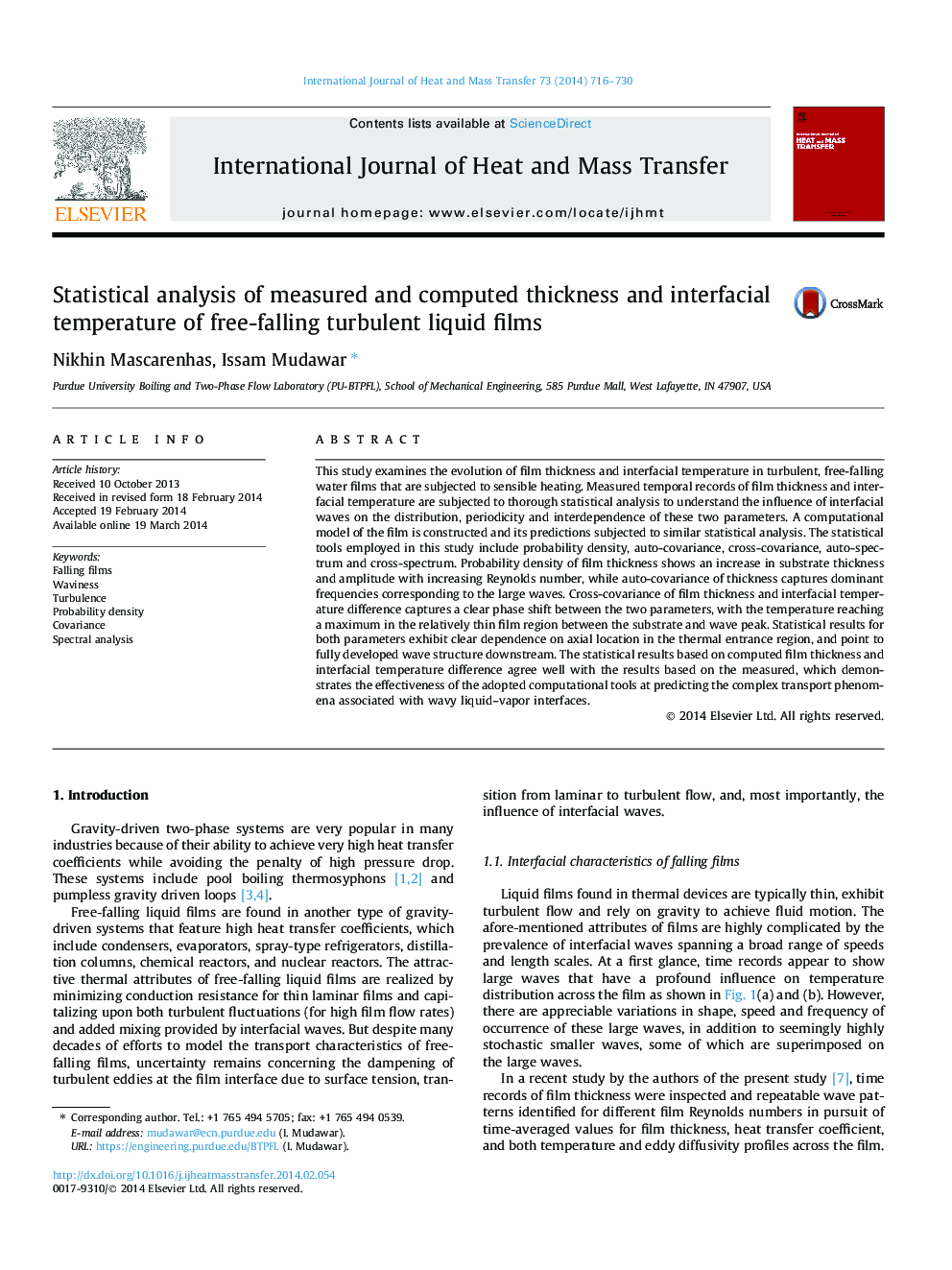| کد مقاله | کد نشریه | سال انتشار | مقاله انگلیسی | نسخه تمام متن |
|---|---|---|---|---|
| 657549 | 1458069 | 2014 | 15 صفحه PDF | دانلود رایگان |
عنوان انگلیسی مقاله ISI
Statistical analysis of measured and computed thickness and interfacial temperature of free-falling turbulent liquid films
ترجمه فارسی عنوان
تجزیه و تحلیل آماری ضخامت های اندازه گیری شده و محاسبه شده و دمای بین فازهای فیلم های مایع آشامیدنی مضر
دانلود مقاله + سفارش ترجمه
دانلود مقاله ISI انگلیسی
رایگان برای ایرانیان
کلمات کلیدی
سقوط فیلم، موجی آشفتگی، چگالی احتمالی، کوواریانس، تجزیه طیفی،
ترجمه چکیده
در این مطالعه، تکامل ضخامت فیلم و دمای بین فاز در فیلم های آشفته و سقوط آزاد که تحت حرارت معقول قرار می گیرند، بررسی می شود. سوابق زمان اندازه گیری شده ضخامت فیلم و دمای بین فاز، تحت تحلیل آماری کامل قرار می گیرند تا نفوذ امواج بین فازی را بر روی توزیع، دوره ای و وابستگی متقابل این دو پارامتر بررسی کنند. یک مدل محاسباتی فیلم ساخته شده است و پیش بینی های آن به تجزیه و تحلیل آماری مشابه می پردازد. ابزار آماری مورد استفاده در این تحقیق شامل چگالی احتمال، خودکار کوواریانس، کوواریانس متقابل، طیف خودکار و طیف متقابل است. چگالی احتمال ضخامت فیلم نشان دهنده افزایش ضخامت و دامنه بستر با افزایش تعداد رینولدز است، در حالی که کوواریانس خودکار ضخامت ضبط فرکانس غالب مربوط به امواج بزرگ است. کوواریانس متقابل ضخامت فیلم و اختلاف دما بین فاز، یک تغییر فاز واضح بین دو پارامتر را نشان می دهد، و دمای آن به حداکثر در منطقه فیلم نسبتا نازک بین بستر و موج می رسد. نتایج آماری برای هر دو پارامتر نشان دهنده وابستگی واضح به موقعیت محوری در ناحیه ورودی حرارتی و اشاره به ساختار موج کاملا توسعه یافته در پایین است. نتایج آماری بر اساس ضخامت فیلم محاسبه شده و اختلاف دمای متغیر با نتایج براساس اندازه گیری همخوانی دارد که نشان دهنده اثربخشی ابزارهای محاسباتی اتخاذ شده در پیش بینی پدیده های حمل و نقل پیچیده مرتبط با رابط های مایع حبابی موجی است.
موضوعات مرتبط
مهندسی و علوم پایه
مهندسی شیمی
جریان سیال و فرایندهای انتقال
چکیده انگلیسی
This study examines the evolution of film thickness and interfacial temperature in turbulent, free-falling water films that are subjected to sensible heating. Measured temporal records of film thickness and interfacial temperature are subjected to thorough statistical analysis to understand the influence of interfacial waves on the distribution, periodicity and interdependence of these two parameters. A computational model of the film is constructed and its predictions subjected to similar statistical analysis. The statistical tools employed in this study include probability density, auto-covariance, cross-covariance, auto-spectrum and cross-spectrum. Probability density of film thickness shows an increase in substrate thickness and amplitude with increasing Reynolds number, while auto-covariance of thickness captures dominant frequencies corresponding to the large waves. Cross-covariance of film thickness and interfacial temperature difference captures a clear phase shift between the two parameters, with the temperature reaching a maximum in the relatively thin film region between the substrate and wave peak. Statistical results for both parameters exhibit clear dependence on axial location in the thermal entrance region, and point to fully developed wave structure downstream. The statistical results based on computed film thickness and interfacial temperature difference agree well with the results based on the measured, which demonstrates the effectiveness of the adopted computational tools at predicting the complex transport phenomena associated with wavy liquid-vapor interfaces.
ناشر
Database: Elsevier - ScienceDirect (ساینس دایرکت)
Journal: International Journal of Heat and Mass Transfer - Volume 73, June 2014, Pages 716-730
Journal: International Journal of Heat and Mass Transfer - Volume 73, June 2014, Pages 716-730
نویسندگان
Nikhin Mascarenhas, Issam Mudawar,
